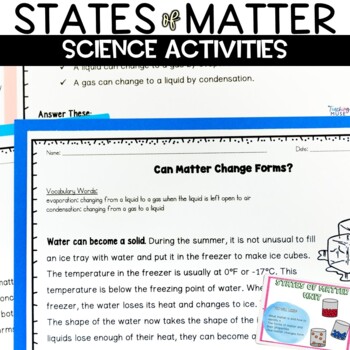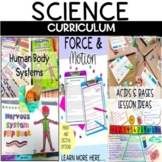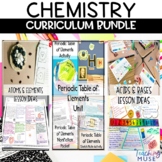States of Matter Worksheets Activity Solids Liquids Gases
- PDF
- Google Apps™

What educators are saying
Also included in
- Teach your students all about the three states of matter using this hands-on, print, and digital science unit. Your students will learn about solid, liquid, and gas substances, their characteristics, and how temperature changes states of matter. In addition to science text worksheets to help teach tPrice $17.32Original Price $24.75Save $7.43
- Looking for a science curriculum to last all school year that will help you teach your physical science, life science, Earth science, and chemistry units? Check out everything this science curriculum has to offer. This year-long science curriculum includes science texts, hands-on activities, classroPrice $326.71Original Price $363.01Save $36.30
- Teach your students about chemistry using these materials that will allow students to read to learn about chemistry concepts and practice what they learned. This Chemistry Bundle includes states of matter, physical and chemical changes, atoms, elements, and the periodic table. This chemistry bundlePrice $100.60Original Price $125.75Save $25.15
Description
Teach your science students the three states of matter using a teacher presentation, print and digital science text, and graphic organizers. Students will understand the characteristics and properties of a solid, liquid, and gas as they answer guided reading and overall comprehension questions. Finally, they'll summarize their learning of the states of matter and changes in matter on two graphic organizers.
Like this activity? Save 20% of the states of matter unit by clicking here.
Students will learn:
- What matter is - a definition for each state
- Characteristics and properties of each phase (volume, shape, and molecules)
- How matter can change with temperature
This states of matter lesson include:
- Teacher instructions to distribute this lesson to your students through your preferred learning management system, such as Google Classroom or Schoology.
- Teacher presentation to introduce the topic to your students
- Student fill in notes to follow along with teacher presentation
- Nine-page printable packet
- Links to the digital activity
- Two graphic organizers in print and digital form
- Answer key
How to use this lesson in your classroom:
- Introduce solids, liquids, and gases to your students using the teacher presentation. Students will follow along and fill in their note sheets. Along the way, you can stop to elaborate or take student questions.
- Use this states of matter science text to introduce the three phases of matter to your students. Choose to read this aloud as a whole class lesson allowing students time to stop and independently answer the check-in questions or have students work in small groups to read and answer the science text.
- Need sub plans? This lesson can easily be left with a substitute, allowing students to review solid, liquid, and gas characteristics as they complete the worksheets.
- Homework assignment: Try a flipped-classroom approach by assigning the science text for homework to build background knowledge on phases of matter.
- Review activity: Students can complete the graphic organizers using their fill in notes or worksheets to demonstrate their learning.
Feedback from teachers who used this lesson in their classroom:
- I like to use a variety of note taking methods in our small group science class. One of my favorites is "Doodle Notes," similar to these. Generally, my students find notetaking hard, so sheets like these are more engaging and allow students to interact with the materials in different ways. Overall when we used these notes, my students responded positively. Plus, they work great with our interactive notebook format.
- I love that there is a comprehension question after each paragraph rather than at the end of the entire reading. This made it much more manageable for my special education students. These readings also include great science content moving beyond sorting states of matter, appropriate for older students.
- Utilized this resource as a review activity with middle school science students and loved how informative this text was and the questions the students had to complete within the content. Exceptional resource!
- A great resource. I love the reading comprehension that I can add to my science class. This is great for helping students to better establish an academic vocabulary. Great practice. Thank you!
- I love these. They are simple, straightforward, and give options for both the student and the teacher. I also love the layout!
This lesson will help prepare students to meet NGSS 5-PS1-1.
Other lessons and activities to support your states of matter unit:
- Anchor Chart Posters
- Hands-on Laboratory Activities and Demonstrations
- Compound and Mixture Activity
- Task Cards; printable, Google Forms and Boom Learning
- Flip Book
- Sketch Notes
- Back to School Color by Number Review
- Fall Fun Thanksgiving Coloring Review
- Winter Fun Color Review Activity
- St Patrick's Day Color Activity
- Digital Escape Room : Science Room
- Project
- FREEBIE Choice Homework Assignments
Kindly Note: If you have questions, do not hesitate to email me at Teaching Muse Email
PLEASE PREVIEW BEFORE PURCHASING
__________________________________________________________________
Thank you for visiting Teaching Muse. I would love for you to become a follower.
Teaching Muse followers receive new product information and discounts on any new items!
__________________________________________________________________
All rights reserved by Teaching Muse. This product is to be used by the original downloader ONLY. Copying for more than one teacher, classroom, department, school, or school system is prohibited. Additionally, this product may not be distributed or displayed digitally for public view. Failure to comply is a copyright infringement and violates the Digital Millennium Copyright Act (DMCA). Intended for classroom and personal use ONLY.








